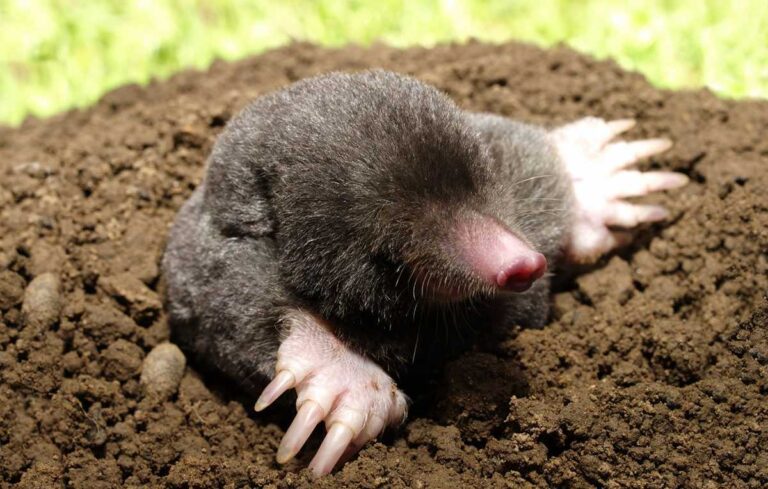How to Identify Snake Holes and What to Pour Down a Snake Hole
The presence of holes in your backyard should be a course for concern. Holes in the yard are perfect hiding and nesting spots for various animals, including gophers, rodents, snakes, and others. However, if you see holes in your backyard, it doesn’t necessarily mean snakes live there. It is an indication that some wildlife has moved into your garden.
Unlike gophers and rodents, snakes can’t burrow and, therefore, inhabit holes that other animals have abandoned. Identifying snake holes in your backyard is certainly terrifying. Below is a guide on how to identify and what to pour down a snake hole.
How to Identify Snake Hole in Your Yard
The biggest challenge facing most homeowners and gardeners is identifying snake holes in their gardens. As mentioned, many other garden animals can burrow or dig holes in the backyard. Therefore, you shouldn’t panic anytime you see holes in your yard. Chances are the holes belong to rodents and gophers. You should identify if the holes exclusively belong to snakes and whether snakes live there.
Since you can’t monitor your garden to see the snake entering or leaving the hole, you should look for the following signs of snake presence in your garden:
1. Small Entry Hole
A small entry hole in your garden, measuring around 2 inches, is closely associated with snake burrows. This size is enough for the snake to pass through, as they often squeeze their bodies to fit holes and spaces that accommodate their head size only. Snake holes also often appear smooth and neatly rounded, without the sharp burrows made by mammals.
Snakes also prefer discreet locations in the garden. They like locations with ample sheds, warmth, and close to potential prey. As such, you’ll easily find snake holes near structures and vegetation, where they can easily ambush their prey.
2. Shedding skin
Snakes are the only known animal that sheds its skin naturally. Shedding the skin helps snakes get rid of parasites and dead cells. Snakes rub themselves against rocks, branches, and other hard surfaces to peel their skin off. You should suspect snake presence in your garden if you come across some segments of its skin.
Remember to inspect your garden routinely if you’ve identified small holes in your garden. The peeling skin is good food for insects and rodents. This means you might not easily find it if you don’t conduct regular inspections.
3. Fecal matter
Fecal matter is the other common sign of snake presence in your backyard. Unfortunately, most homeowners don’t know how to identify snake-specific fecal matter. Ideally, a snake’s fecal matter should be pasty and thick, contain traces of rodents and insects, and have whiteish substances.
That said, if you find holes in your backyard, fecal matter, and shed skin, you can be sure that you are sharing your backyard with a slithering animal.
Which Type of Snakes Dig Holes in the Yard?
With over 3000 species of snakes globally, identifying the type of snake in your garden can prove daunting. However, not all snake types can dig holes in your garden. The first step to dealing with snakes in your garden is identifying the type of snake in your backyard. Some common snake species that invade gardens include:
· Gopher snake
Gopher snakes are very common snakes in Northern California that most people mistake for rattlesnakes. Gophers have gray to dark brown bodies with alternating black and brown spots. They are diurnal snakes, which means they go hunting during the daytime and sleep at night. Gopher snakes are not dangerous and are nonvenomous. They only feed on birds, mammals, and eggs.
· Kingsnakes
Kingsnakes are nonvenomous snakes that kill prey by constricting. Most people confuse kingsnakes with coral snakes and other venomous species because of the bands of color that runs down their back. Kingsnakes can grow up to 48 inches in length and survive on rodents, birds, and lizards.
· Rat snakes
Rat snakes are similar to garter snakes. While they vary in pattern and color, they have dark bodies with light underbellies and chins. Rat snakes are excellent climbers and swimmers and frequent areas with a lot of trees and water.
· Garter snakes
They are also common in North America with characteristic three stripes along their bodies. They have arrow-shaped heads that are larger than necks and can grow up to 54” in length. Like black snakes and gopher snakes, garter snakes eat birds, small mammals, and insects.
· Rattlesnakes
Rattlesnakes are very different from other snake species mentioned above. While they all burrow holes in the yard, rattlesnakes are venomous and a threat to humans. Pacific rattlesnakes, which is the common type across Northern California, have triangular heads and grow up to 5.5 feet long. They have body colors ranging from black to dark gray and hexagonal markings. These snakes are most active during summer and spring and hibernate from November to February.
What to Do About Snake Holes in Your Yard
Realizing that you are sharing your backyard with snakes is certainly scary. However, what should you do immediately if you find snake holes in your yard? You should weigh the following options, keeping in mind the safety of your family and pets in the garden:
1. Leave it Alone
The best thing to do is to leave the snake undisturbed. In most situations, the snake in your backyard is nonvenomous and most likely shy. Most backyard snakes, especially the garter species, are shy and hide or avoid human paths. Garden snakes typically live in peace and will slither away when disturbed.
Leaving snakes in your garden is also generally beneficial. Snakes feed on rodents, insects, and frogs, making them a surprisingly positive addition to your garden. Therefore, unless you extremely fear snakes, leaving them alone is the best option. However, this isn’t a prudent option for homeowners with kids and pets who like enjoying the outdoors.
2. Cover the Snake Hole
The second and most preferred option by homeowners is covering the snake hole. Snakes essentially like privacy, which is why they hide in dark and cool holes. They can also nest within crevices and under old stumps. Blocking or covering snake holes in your garden will disturb their habitat, discouraging their return to your garden.
If this is your preferred option, consider using boards, burlap, or wire fencing. However, you should cover the holes carefully as you can create a new place for snakes to burrow themselves in. Similarly, prepare for a confrontation if you want to interfere with their habitat.
Always ensure the snake is outside the hole before proceeding to cover it. Remember, snakes get easily irritated and will most likely attack or retaliate if they feel attacked. You should also wear protective gloves all the time. Snakes will leave your garden if the snake finds its “home” covered and uninhabitable.
3. Call a Professional Exterminator
Calling a professional exterminator is the third and most effective way of dealing with snakes in your garden. You should opt for this method if you verily dislike sharing your personal space with the snake or don’t have time to cover the snake holes on your own. You should also call an exterminator if you suspect the snake in your garden is venomous.
The professional exterminator will inspect your backyard and suggest various plausible solutions. They can either recommend trapping, which is effective but costly because it requires using an expensive snake fence, or the use of glue boards, which is effective but messy.
What to Pour Down a Snake Hole
Dealing with stubborn snakes requires that you find ways of getting rid of them from your backyard. Below are a few things you can pour down a snake hole to eliminate them:
1. Apply snake repellents
Snake repellents do just as the name suggests. They produce an unpleasant smell that limits the entry of snakes into your garden. Unfortunately, the effectiveness of snake repellents varies, and some products don’t repel some snake species.
Snake repellents contain natural and chemical ingredients designed to repel snakes. Most repellents contain sulfur, cinnamon oil, naphthalene, and clove oil as their key ingredients. These products should ideally be applied around the garden or perimeter of the specified area.
While these repellents are effective, their main limitation is that their working ability is affected by various factors, specifically weather conditions, type of soil, and snake species in your area. Some snakes also become accustomed to the odor, reducing the effectiveness of these repellants.
2. Pour compacted stone or soil into the snake hole
You can also pour compacted stone or soil into the snake hole in your yard. The idea behind this method is to make the garden less appealing and minimize accessibility for snakes. Snakes often find it difficult to navigate compacted stone or soil. While this solution is effective, you should keep the following in mind:
- Compacted soil or stone is a temporary solution. It deters snakes from getting into your garden temporarily. Snakes easily adapt and can find alternative ways of accessing their preferred areas.
- Compacted soil or stone has negative environmental effects. Using these materials excessively can potentially harm the natural habitat and other organisms.
- You should combine this method with other methods of deterring snakes in your yard. For instance, you should also clear debris and tall grass that make your yard habitable for prey that snakes feed on.
- Sealing snake holes in your yard with compacted stone has several inherent risks. For instance, you might trap a venomous snake inside, which can endanger another person who uncovers the hole later.
This option appears simple, but you’ll require professional assistance. Professionals also come in handy if you aren’t sure of the type of snake species in your garden.
3. Flushing snake hole with water
You can also eliminate snakes from your garden by flushing their holes with water. The rationale behind this is to flood the hole and make it uncomfortable for the snake to hide in it. However, you should consider several factors before using this option. For starters, the effectiveness of flushing water in a snake hole varies. Some snakes are excellent swimmers and can tolerate water.
You should also consider the safety implications of flushing water, especially if you are dealing with venomous snakes as they easily get agitated. Always keep a safe distance and take appropriate safety precautions. Similarly, ensure there is an alternative escape route for the snake before flushing water into the hole. Trapping the snake in the hole is very risky.
4. Put steel wool in the snake hole
Putting steel wool in the snake hole is also an effective way of deterring snakes. The simple idea behind this is that steel wool’s rough texture makes the hole uncomfortable for snakes, discouraging them from entering it. Based on this, the effectiveness of using steel wool to deter snakes varies. Some people report success using this method, while others claim that some snake species push through the steel wool.
The key to the success of this method is ensuring the steel wool is packed tightly enough. Snakes are very flexible and can pass through small gaps. You should also check local regulations and guidelines before using steel wool to deter snakes. Some local guidelines have restrictions on the materials that can be used against animals.
As with compacted stone, steel wool becomes more effective if used alongside other snake preventive measures. For instance, you should ensure the garden is clutter-free to reduce hiding spots.
How to Keep Snakes Away from Your Yard
The best way to avoid seeing snake holes in your garden is to ensure that snakes aren’t within your yard’s vicinity. You should combine various strategies to make your yard less attractive to snakes and reduce hiding spots. They include:
1. Reduce food sources
Like pests and rodents, snakes will find their way into your garden if there’s food. Therefore, ensuring that your garden lacks food sources makes it less attractive and habitable for snakes. You can achieve this by:
- Control rodent populations – rodents are a great diet for snakes of all species. Implement various rodent control strategies to reduce snakes’ primary source of food.
- Store pet food securely – snakes also feed on pet food and can lead them into your house. You should store pet food in sealed containers and always feed them indoors. Leftovers attract rodents and, ultimately, snakes.
- Remove bird feeders – like pet food, bird feeders attract rodents, which, in turn, attract snakes to your garden.
- Reduce compost odors – you should minimize compost odors for the same reason. Compost creates a food source for rodents, which attracts snakes.
Eliminating various factors that attract rodents indirectly deters snakes from frequenting your yard.
2. Clear clutter from your garden
Cleaning your yard also makes your yard less appealing to snakes. Trimming vegetation, and removing debris, firewood, and other garden clutter eliminates potential hiding spots, making your yard unfavorable for snakes. You should also avoid overwatering, keep garden beds tidy, and conduct regular inspections, especially under the deck, sheds, and garden structures. Seal open gaps and crevices in garden structures.
3. Seal potential entry points
Sealing entry points is another proactive way of preventing snakes from entering your property. However, snakes can find their way into your garden through very small openings that you can easily overlook. Blocking entryways reduces the risk of snakes ending up in your garden.
The best way to seal entry points is by installing a snake-proof fence around your property. The fence should extend into the ground to prevent snake entry through burrowing.
4. Grow snake-repelling plants
Snake-repellent plants effectively deter snakes from entering your yard. While there’s not much scientific evidence backing this theory, some homeowners have successfully used this method as part of a comprehensive snake management strategy. That said, you should grow the following plants:
- Marigolds – they are considered snake repellent because of their strong scent, which some people believe snakes don’t like.
- Onion – the strong smell of onions also deters snakes.
- West Indian lemongrass – lemongrass produces a strong citrus scent that also deters snakes.
You should incorporate these plants into your overall landscaping strategy. However, remember the evidence supporting the effectiveness of these plants is anecdotal, and results may vary. Besides, you shouldn’t solely rely on plants for complete protection. You should combine the use of these plants with other snake management techniques like tidying your yard and sealing entry points for utmost effectiveness.
The Bottom Line
Most homeowners don’t know how to live harmoniously with snakes in their gardens. If small holes in your garden are confirmed to harbor snakes, you should know what to pour down a snake hole. Remember, all snake species are harmful to humans and pets if threatened. If you can’t handle the snake problem in your garden, you should seek professional help.






